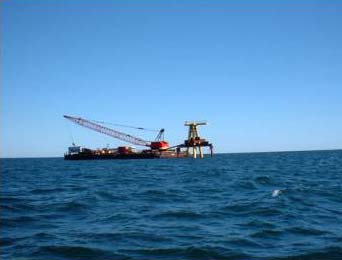Call me Ishmael

ASIT with platform in place
Air-sea interaction tower built off Martha’s vineyard
In the deep waters two miles south of Edgartown on Martha’s Vineyard, not far from where, two centuries ago, the likes of Captain Ahab and a thousand others kept their watch for the great white and his kin, we are now searching to understand another potential beast in those parts: the ocean and the weather.
But this is no allegory. Hoping to avoid any recurrence in these sometimes turbulent waters of the horrendous storms so intensely portrayed in Moby Dick as well as The Perfect Storm, the Office of Naval Research has built a tower bristling from top to bottom with sensors. The Air-Sea Interaction Tower will continually measure atmospheric and ocean conditions such as air temperature, humidity, solar radiation and carbon dioxide, as well as water temperature, salinity or salt content, wave height and direction, water circulation, current speed and direction, and sediment transport. It will directly measure momentum, heat, and mass exchange between the atmosphere and ocean. Anchored 50 feet down into the ocean floor, the tower extends 76 feet into the marine atmosphere. It will be maintained and operated by scientists at the Woods Hole Oceanographic Institution (WHOI) in Massachusetts and will be connected by undersea cables to WHOI’s Martha’s Vineyard Coastal Observatory (MVCO).
“No one has ever built this kind of thing before. Understanding how the ocean and atmosphere interact under all conditions, and understanding the factors that affect the exchange of energy between the ocean and atmosphere, how readily carbon dioxide is exchanged, and how currents and waves affect bottom sediments, makes for better weather forecasts,” says science officer Simon Chang who oversees the project for ONR. “Avoiding storms and correctly and precisely forecasting bad weather saves lives.”
Power and data transmission from the Tower are supplied the underwater cable linked to MVCO. Data gathered will be integrated with MVCO data and made directly available to all users and to the general public via the MVCO web site at http://www.whoi.edu/mvco. The data will include wind speed and direction, air and sea temperature, wave height and direction, and currents at the offshore site.
“This is a one-of-a kind platform for studying coastal processes in the Atlantic Ocean,” says James Edson of WHOI’s Ocean Physics and Engineering Department, who serves as project engineer. “It will be used by researchers, educators, and students from around the world during its lifetime.”
Ishmael told a good story, but unlike his Captain he did not vow a relentless watch, and a relentless watch is what the Navy wants. Better to call this tower, Ahab.
For more information on the ASIT, or to interview the scientists if you are media., please contact Gail Cleere at ONR, 703-696-4987 or email cleereg@onr.navy.mil.
Media Contact
More Information:
http://www.onr.navy.mil/All latest news from the category: Earth Sciences
Earth Sciences (also referred to as Geosciences), which deals with basic issues surrounding our planet, plays a vital role in the area of energy and raw materials supply.
Earth Sciences comprises subjects such as geology, geography, geological informatics, paleontology, mineralogy, petrography, crystallography, geophysics, geodesy, glaciology, cartography, photogrammetry, meteorology and seismology, early-warning systems, earthquake research and polar research.
Newest articles

Silicon Carbide Innovation Alliance to drive industrial-scale semiconductor work
Known for its ability to withstand extreme environments and high voltages, silicon carbide (SiC) is a semiconducting material made up of silicon and carbon atoms arranged into crystals that is…

New SPECT/CT technique shows impressive biomarker identification
…offers increased access for prostate cancer patients. A novel SPECT/CT acquisition method can accurately detect radiopharmaceutical biodistribution in a convenient manner for prostate cancer patients, opening the door for more…

How 3D printers can give robots a soft touch
Soft skin coverings and touch sensors have emerged as a promising feature for robots that are both safer and more intuitive for human interaction, but they are expensive and difficult…




















